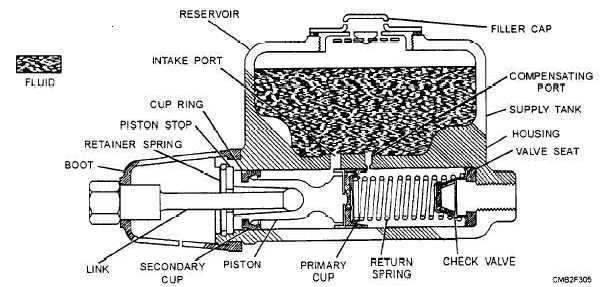Braking Ratio
Braking ratio refers to the comparison of front-wheel to rear-wheel braking effort. When a vehicle stops, its weight tends to transfer to the front wheels. The front tires are pressed against the road with greater force. The rear tires lose some of their grip on the road. As a result, the front wheels do more of the braking than the rear.
For this reason, many vehicles have disc brakes on the front and drum brakes on the rear. Disc brakes are capable of producing more stopping effort than drum brakes. If drum brakes are used on both the front and rear wheels, the front shoe linings and drums typically have a larger surface area.
Typically, front-wheel brakes handle 60 to 70 percent of the braking power. Rear wheels handle 30 to 40 percent of the braking. Front-wheel drive vehicles, having even more weight on the front wheels, have even a higher braking ratio at the front wheels.
HYDRAULIC SYSTEM
The hydraulic system applies the brakes at all four wheels with equalized pressure. It is pedal operated. The system consists of the master cylinder, the wheel cylinder, the brake lines and hoses, and the brake fluid.
Master Cylinder
The master cylinder is the primary unit in the brake system that converts the force of the operator's foot into fluid pressure to operate the wheel cylinders. It is normally mounted to the firewall, which allows for easy inspection and service, and is less prone to dirt and water. The master cylinder has four basic functions that are as follows:
It develops pressure, causing the wheel cylinder pistons to move towards the drum or rotor.
After all of the shoes or pads produce sufficient friction, the master cylinder assists in equalizing the pressure required for braking.
It keeps the system full of fluid as the brake linings wear.
It can maintain a slight pressure to keep contaminants (air and water) from entering the system.
In its simplest form, a master cylinder consists of a housing, a reservoir, a piston, a rubber cup, a return spring, a rubber boot, and a residual pressure check valve (fig. 7-4). There are two ports (inlet port and compensating port) drilled between the cylinder and reservoir. The description of the components of a master cylinder is as follows:
The master cylinder housing is an aluminum or iron casting having either an integral or detachable reservoir. A cylinder is machined in the housing of the master cylinder. The spring, the cups, and the metal piston move within this cylinder.
The piston is a long spoonlike member with a rubber secondary cup seal at the outer end and a rubber primary cup at the inner end, which are used to pressurize the brake system. The primary cup is held against the end of the piston by the return spring. A steel stop disc, held in the outer end of the cylinder by a retainer spring, acts as a piston stop.

Figure 7-4. - Cutaway view of a single master cylinder.
Continue Reading